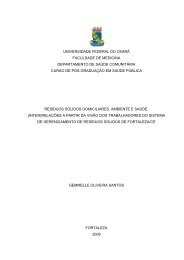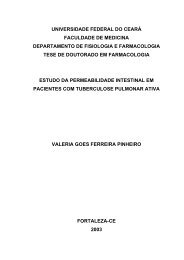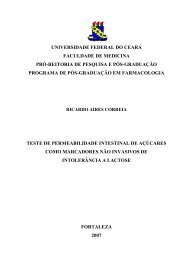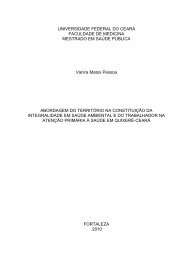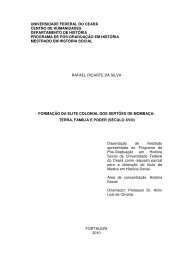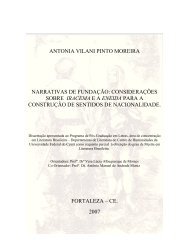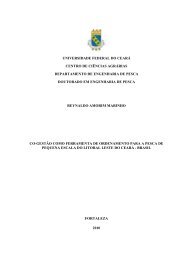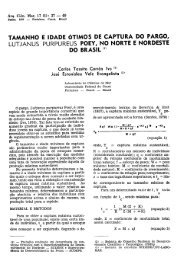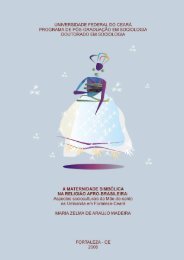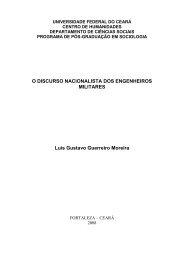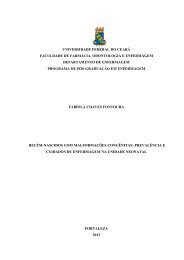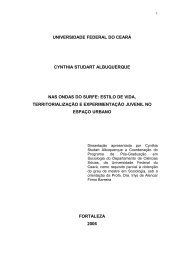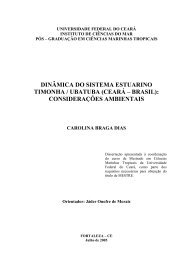Tungíase: doença negligenciada causando patologia grave
Tungíase: doença negligenciada causando patologia grave
Tungíase: doença negligenciada causando patologia grave
Create successful ePaper yourself
Turn your PDF publications into a flip-book with our unique Google optimized e-Paper software.
Figure 1. Prevalence of tungiasis stratified by age group and severity of infestation.<br />
doi:10.1371/journal.pntd.0000087.g001<br />
printing, a spreadsheet containing details of their biodata. Data<br />
were kept strictly confidential.<br />
Results<br />
Of the 643 individuals of the target population, 557 (86.6%)<br />
were encountered and participated in the study. This represents<br />
45.2% of the total population of the community. Of the<br />
participants, 299 (53.7%) were male and 258 (46.3%) female.<br />
Illiteracy rate was high (n = 445; 77.2%), and 100 individuals<br />
(56.5%) of the adult working population had a mean monthly<br />
income,US$50. Most people lived in brick houses (n = 414;<br />
74.3%); 277 (49.7%) had inside a floor of sand or clay, 363 (65.2%)<br />
did not have any toilet facilities, and 326 (58.5%) littered domestic<br />
waste within the house premises. Seventy two (12.9%) individuals<br />
walked barefooted.<br />
In total, 252 (42.5%) individuals were infested with T. penetrans.<br />
Of these, 122 (48.4%) presented with mild, 105 (41.7%) with<br />
moderate, and 25 (9.9%) with heavy infestation. The age-specific<br />
prevalences and intensities of infestation are shown in Figure 1.<br />
Prevalence followed an S-shaped pattern and was highest in<br />
children 5 to 9 years of age, 10 to 15-years old adolescents and the<br />
elderly. The highest proportion of individuals with heavy<br />
infestation was observed in the elderly.<br />
Factors associated with tungiasis in the bivariate analysis are<br />
depicted in Table 1. Variables of all groups were detected to be<br />
associated with tungiasis. Odds ratios.10 were found for<br />
community members living in houses made of palm products;<br />
living in houses with sand or clay floor; with water supply<br />
Tungiasis in Nigeria<br />
exclusively from the river; with pigs on the compound, and those<br />
usually resting outdoors (Table 1). Other variables significantly<br />
associated with infestation included young age (OR = 9.0), low<br />
education (OR = 10.0), lack of knowledge on transmission<br />
(OR = 7.22), no regular use of footwear (OR = 5.9), no use of<br />
soap for bathing (OR = 5.9), and the non-use of commercialized<br />
insecticides used as a means of prevention (OR = 9.3).<br />
Figure 2. A single tungiasis lesion on the finger of a 7-year-old<br />
boy from Brazil, with surrounding erythema.<br />
doi:10.1371/journal.pntd.0000087.g002<br />
PLoS Neglected Tropical Diseases | www.plosntds.org 3 2007 | Volume 1 | Issue 3 | e87



